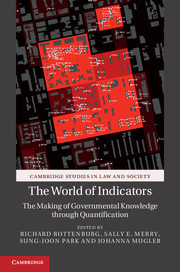Book contents
- Frontmatter
- Contents
- List of figures
- List of tables
- List of abbreviations
- List of contributors
- 1 A world of indicators: The making of governmental knowledge through quantification
- 2 The flight of the indicator
- 3 Narrating numbers
- 4 By their own account: (Quantitative) Accountability, Numerical Reflexivity and the National Prosecuting Authority in South Africa
- 5 Failure by the numbers? Settlement statistics as indicators of state performance in South African land restitution
- 6 Doing the transparent state: Open government data as performance indicators
- 7 Charting the road to eradication: Health facility data and malaria indicator generation in rural Tanzania
- 8 ‘Nobody is going to die’: An ethnography of hope, indicators and improvizations in HIV treatment programmes in Uganda
- 9 Financial indicators and the global financial crash
- 10 New global visions of microfinance: The construction of markets from indicators
- 11 Spirits of neoliberalism: ‘Competitiveness’ and ‘wellbeing’ indicators as rival orders of worth
- 12 Climate change vulnerability indicators: from noise to signal
- 13 Retroaction: how indicators feed back onto quantified actors
- Index
- Cambridge Studies in Law and Society
- References
7 - Charting the road to eradication: Health facility data and malaria indicator generation in rural Tanzania
Published online by Cambridge University Press: 05 October 2015
- Frontmatter
- Contents
- List of figures
- List of tables
- List of abbreviations
- List of contributors
- 1 A world of indicators: The making of governmental knowledge through quantification
- 2 The flight of the indicator
- 3 Narrating numbers
- 4 By their own account: (Quantitative) Accountability, Numerical Reflexivity and the National Prosecuting Authority in South Africa
- 5 Failure by the numbers? Settlement statistics as indicators of state performance in South African land restitution
- 6 Doing the transparent state: Open government data as performance indicators
- 7 Charting the road to eradication: Health facility data and malaria indicator generation in rural Tanzania
- 8 ‘Nobody is going to die’: An ethnography of hope, indicators and improvizations in HIV treatment programmes in Uganda
- 9 Financial indicators and the global financial crash
- 10 New global visions of microfinance: The construction of markets from indicators
- 11 Spirits of neoliberalism: ‘Competitiveness’ and ‘wellbeing’ indicators as rival orders of worth
- 12 Climate change vulnerability indicators: from noise to signal
- 13 Retroaction: how indicators feed back onto quantified actors
- Index
- Cambridge Studies in Law and Society
- References
Summary
Introduction
Speaking at a gleaming office building in midtown Manhattan two days before the start of the sixty-sixth General Assembly at United Nations headquarters, Jakaya Kikwete, President of Tanzania and Chair of the African Leaders Malaria Alliance (ALMA), announced the launch of the ALMA Scorecard for Accountability and Action (depicted in part in Figure 7.1, green/yellow/red/grey colors in original replaced with grey scale). Underscoring the significance of this event, President Kikwete explained that the ALMA Scorecard would be an excellent tool for advancing malaria research and control efforts in sub-Saharan Africa, where the continent bears the brunt of the mosquito-borne affliction:
We, the leaders of Africa, are ultimately responsible for keeping our citizens safe from malaria. With the help of this new tool, ALMA is committed to delivering on our promise to end malaria deaths for our citizens and for all of Africa. The ALMA Scorecard for Accountability and Action measures progress, but it also inspires action by African Heads of State and Government.
(ALMA 2011)The endorsement by over forty African Heads of State and the African Union of the ALMA Malaria Scorecard, which depicts country achievements on various core indicators and targets, illustrates the striking transformation of malaria during the past decade from a neglected disease to one that is commanding considerable resources and political action. Updated every four months, the ALMA Scorecard, divided into fourteen columns, each depicting a particular malaria-related indicator, is intended as a handy visual tool for African leaders and policy-makers. It deploys a ‘traffic light color scheme’ to identify areas where more effort is needed: green (signified by in the modified ALMA chart in Figure 7.1) indicates that a country is on track for that indicator; yellow (signified by) alerts that more effort is required; while red (signified by in Figure 7.1) warns of (impending) failure. The fourteen indicators depicted in the Scorecard are selected from a much larger ‘dream list’ of potentially relevant indicators which ALMA aims to include when consistent and reliable data from internationally recognized sources become available. Through its color-coded simplicity, the ALMA Scorecard aims to usher African leaders and policy-makers down a mutually agreed-upon path toward the ultimate goal: eliminating malaria as a public health problem in sub-Saharan Africa.
- Type
- Chapter
- Information
- The World of IndicatorsThe Making of Governmental Knowledge through Quantification, pp. 151 - 187Publisher: Cambridge University PressPrint publication year: 2015
References
- 10
- Cited by



